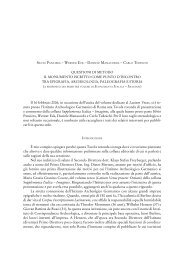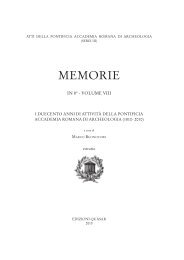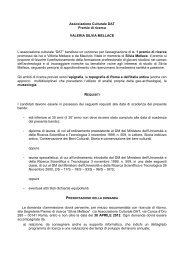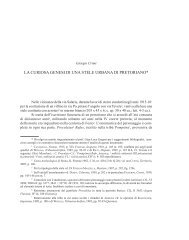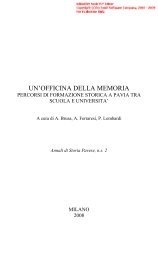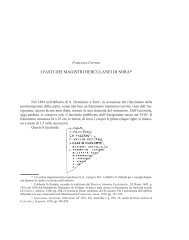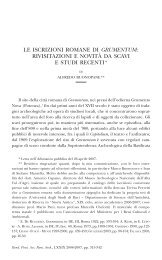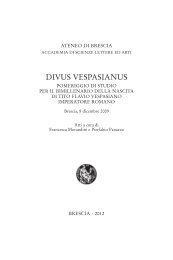There Are No cursus honorum Inscriptions. The Function of the ...
There Are No cursus honorum Inscriptions. The Function of the ...
There Are No cursus honorum Inscriptions. The Function of the ...
Create successful ePaper yourself
Turn your PDF publications into a flip-book with our unique Google optimized e-Paper software.
86 THERE ARE NO CURSUS HONORUM INSCRIPTIONS<br />
inscription from Comum, where he displayed his full <strong>cursus</strong> <strong>honorum</strong> as well as all his<br />
benefactions to his home town for all to see. This text, part <strong>of</strong> which can be seen in San<br />
Ambrogio in Milan, was presented to <strong>the</strong> public in <strong>the</strong> library founded by him in<br />
Comum, probably established after his death and in accordance with his last will and<br />
testament. 25<br />
Moreover, <strong>the</strong> example <strong>of</strong> ano<strong>the</strong>r senator, a contemporary <strong>of</strong> Pliny, shows that <strong>the</strong><br />
continuous updating <strong>of</strong> <strong>the</strong> curriculum vitae, i.e. <strong>the</strong> written version <strong>of</strong> <strong>the</strong> <strong>cursus</strong><br />
<strong>honorum</strong>, was by no means unique to <strong>the</strong> consular senator from Barcino in Spain, but<br />
ra<strong>the</strong>r a feature common to many members <strong>of</strong> <strong>the</strong> contemporary elite.<br />
Q. Glitius Atilius Agricola, one <strong>of</strong> <strong>the</strong> most outstanding senators during <strong>the</strong> reigns <strong>of</strong><br />
Domitian and Trajan, came from Augusta Taurinorum, not very far from Comum. 26<br />
Domitian sent him as legate to <strong>the</strong> province <strong>of</strong> Belgica, where he also served for a short<br />
period under Nerva. In 97, he became consul suffectus, toge<strong>the</strong>r with L. Pomponius<br />
Maternus (and not, as was supposed for a long time, with <strong>the</strong> much better known<br />
Cornelius Tacitus). 27 He was honoured in his hometown with numerous statues at<br />
various stages <strong>of</strong> his career, namely with statuae equestres, but not with equestrian<br />
statues that stand on solid and massive stone bases. <strong>The</strong>se statues stood on a plate that<br />
rested on top <strong>of</strong> two trapezophora. This type <strong>of</strong> equestrian statuary became known only a<br />
few years ago, following a publication by my colleague, <strong>the</strong> archaeologist Henner v.<br />
Hesberg, and myself. An inscription that accounted for <strong>the</strong> statue was engraved on <strong>the</strong><br />
frontal trapezophoron. 28 <strong><strong>The</strong>re</strong> were at least eight such monuments and inscriptions for<br />
Glitius Agricola in Augusta Taurinorum. 29 <strong>The</strong> tributes were made by several cities or<br />
groups <strong>of</strong> individuals at various stages in this senator’s career, and <strong>the</strong> accompanying<br />
texts on <strong>the</strong> trapezophora kept up with his progress, adding <strong>the</strong> new <strong>of</strong>fices occupied as<br />
Glitius Agricola’s career went on. <strong>The</strong> earliest ones belonged to <strong>the</strong> period before<br />
Nerva’s death. In both <strong>the</strong>se texts his governorship in Belgica was formulated in <strong>the</strong><br />
normal way:<br />
[lega]to pro praetor. [im]p. Nervae Caes. Aug. provinciae Belgicae. 30<br />
First <strong>the</strong> governor’s title, followed by <strong>the</strong> name <strong>of</strong> <strong>the</strong> emperor and finally <strong>the</strong> province.<br />
25 On <strong>the</strong> reconstruction <strong>of</strong> <strong>the</strong> inscription see G. Alföldy, ‘Die Inschriften des Jüngeren<br />
Plinius und seine Mission in Pontus et Bithynia’, Festschrift für St. Borzsák, AAntHung. 39,<br />
1999, 21 ff. = in: Idem, Städte, Eliten und Gesellschaft in der Gallia Cisalpina, Stuttgart<br />
1999, 221 ff.; on <strong>the</strong> function <strong>of</strong> <strong>the</strong> inscription W. Eck, ‘Die große Pliniusinschrift aus<br />
Comum: Funktion und Monument’, in: Varia Epigraphica. Atti del Colloquio<br />
Internazionale di Epigrafia, Bertinoro, 8-10 giugno 2000, eds. A. Bertinelli and A. Donati,<br />
Faenza 2001, 225 ff.; Id., ‘Rome and <strong>the</strong> Outside World. Senatorial Families and <strong>the</strong> World<br />
<strong>The</strong>y Lived in’, in: <strong>The</strong> Roman Family in Italy: Status, Sentiment, Space, eds. B. Rawson<br />
and P. Weaver, Oxford 1997, 73 ff.<br />
26 PIR 2 G 181; Alföldy in: Städte, Eliten (note 25 above), 229 f.<br />
27 W. Eck and A. Pangerl, ‘Zwei Konstitutionen für die Truppen Niedermösiens vom 9.<br />
September 97’, ZPE 151, 2005, 185 ff.<br />
28 W. Eck and H. v. Hesberg, ‘Tische als Statuenträger’, MDAI (R) 111, 2004 [2006], 143 ff.<br />
29 CIL V 6974-6987 (Augusta Taurinorum); on <strong>the</strong> one Greek text in this series see briefly F.<br />
Battistoni, ‘Missing Relative?’, ZPE 2009 (in press).<br />
30 CIL V 6574 = ILS 1021 (Augusta Taurinorum).



